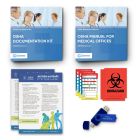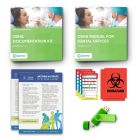Under OSHA regulations, the biohazards that your decontamination process and agents must be effective against are determined by the risks you have in your office. For example, if your office treats patients with HIV and HBV, your disinfection process and disinfectants need to be effective against HIV and HBV. In general, you also want to make sure you cover any common biohazards – household bacteria and viruses for example (OSHA deems a bleach solution as effective). Once you’ve identified what agents you must eliminate, you move on to the next step - identifying appropriate disinfectants.
Regulatory references:
1. 1910.1030(d)(4)(ii)(A) – Contaminated work surfaces shall be decontaminated with an appropriate disinfectant after completion of procedures; immediately or as soon as feasible when surfaces are overtly contaminated or after any spill of blood or other potentially infectious materials; and at the end of the work shift if the surface may have become contaminated since the last cleaning.
2. Severe surface decontamination can be done using bleach (see this OSHA Decontamination Fact Sheet)
How to Identify Disinfection Products:
OSHA requires that you use “appropriate” disinfectants. In a letter of interpretation (considered legal guidance by OSHA), they defined “appropriate” as disinfectants that are EPA-registered and are labeled as effective against the hazard in question when used according to the manufacturer's guidelines. You can determine this from the manufacturer label, or by contacting the manufacturer.
Here is an excerpt from that letter of interpretation:
A review of the initial intent of the Bloodborne Pathogens Standard that specifically deals with the cleaning of contaminated work surfaces, i.e., 1910.1030(d)(4)(ii)(A), reveals that OSHA intended to provide a performance-based provision that would allow for future development of "appropriate disinfectant" products. OSHA has reviewed the information on the disinfectants and has reconsidered its position on EPA-registered disinfectants that are labeled as effective against HBV and HIV. OSHA's current stance is that EPA-registered disinfectants for HIV and HBV meet the requirement in the standard and are "appropriate" disinfectants to clean contaminated surfaces, provided such surfaces have not become contaminated with agent(s) or volumes of or concentrations of agent(s) for which higher level disinfection is recommended.
It is important to emphasize the EPA-approved label section titled "SPECIAL INSTRUCTIONS FOR CLEANING AND DECONTAMINATION AGAINST HIV-1 AND HBV Of SURFACES\OBJECTS SOILED WITH BLOOD\BODY FLUIDS." On the labels that OSHA has seen, these instructions require:
1. personal protection devices for the worker performing the task;
2. that all the blood must be cleaned thoroughly before applying the disinfectant;
3. that the disposal of the infectious waste is in accordance with federal, state, or local regulations;
4. that the surface is left wet with the disinfectant for 30 seconds for HIV-1 and 10 minutes for HBV.
OSHA would expect all such disinfectants to be used in accordance with their EPA-approved label instructions.
Additionally, the choice of disinfectants for your facility depends on factors such as low allergenicity for both patients and employees, short contact time, compatibility with surfaces in your facility, ease of use, etc.
Required OSHA Policies and Documentation:
OSHA requires that you have a “Housekeeping” policy that explains what disinfectants you use, tasks and procedures to be performed, and locations to be cleaned. The OSHA Housekeeping Hospital eTool (applicable even for dental healthcare providers) is an excellent resource that will help you develop your procedure.
If you’re looking for an easily customizable and ready-made protocol for Housekeeping and other required OSHA policies, check out our OSHA packages.
About Us:
At Gamma Compliance Solutions, we come to work every day because we want to solve the biggest problem in regulatory compliance: helping you make sure you’ve met all the requirements. Over the years, we’ve developed different compliance packages to suit practices at any stage in the OSHA and HIPAA compliance process. We’ve designated this area of our blog to post important updates and share key resources and guidelines you need to best protect your employees and yourselves. In addition to checking this area of our blog, follow us on social media to receive notifications when we share important information.



